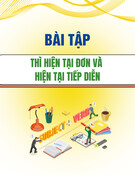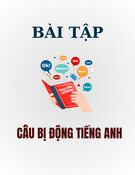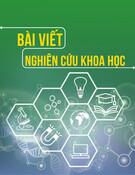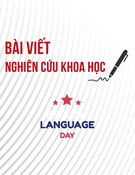
ISSN: 2615-9740
JOURNAL OF TECHNICAL EDUCATION SCIENCE
Ho Chi Minh City University of Technology and Education
Website: https://jte.edu.vn
Email: jte@hcmute.edu.vn
JTE, Volume 19, Special Issue 03, 2024
102
Computer-Mediated Communication: Application to Vocational English
Education
Thi Quynh Nhu Ho
Hue Industrial College, Vietnam
Corresponding author. Email: htqnhu@hueic.edu.vn
ARTICLE INFO
ABSTRACT
Received:
19/05/2023
Recent research on the use of computer-mediated communication (CMC)
tends to focus on how CMC occurs and how to effectively apply Internet-
based technologies into classrooms in general while little evidence has
been found on the application of CMC tools to teach English language for
workplace purposes. Therefore, this article aims to explore the use of CMC
as an alternative platform for teaching English for vocational purposes. For
this purpose, the current paper is based on library research combining
synthesis and analysis of more than thirty empirical and non-empirical
articles which were published in journals, conference proceedings, books,
and conference presentations. The findings center around specifying: (i)
the characteristics of vocational English education and the key theoretical
frameworks and pedagogical models that underpin the use of CMC in
teaching English for vocational purposes; (ii) the impacts of CMC mode
on the students’ language learning outcomes and vocational skill
development, and (iii) the needed preparation of educators for the
successful use of CMC. The results offer insights into the growth of CMC
use as an effective platform in vocational English education.
Revised:
31/07/2023
Accepted:
07/09/2023
Published:
28/08/2024
KEYWORDS
Computer-mediated communication
(CMC);
English language education;
English for specific purposes (ESP);
English for occupational purposes
(EOP);
English for vocational purposes (EVP).
Doi: https://doi.org/10.54644/jte.2024.1413
Copyright © JTE. This is an open access article distributed under the terms and conditions of the Creative Commons Attribution-NonCommercial 4.0
International License which permits unrestricted use, distribution, and reproduction in any medium for non-commercial purpose, provided the original work is
properly cited.
1. Introduction
Over the past decades, the development of high-tech devices such as computers, laptops, tablets, and
cell phones in combination with the widespread and excessive use of internet-based technologies
worldwide has influenced the ways people live, work, and study. Among the recent modern gadgets, the
popularity of computers has highlighted the role of CMC as a very effective medium of interaction
between people from different parts of the world.
Numerous definitions have been made to the concept of CMC from a plethora of perspectives. In
1991, Higgins defined CMC as “human communication via computer" [1]. It can be understood that this
mode involves interaction between individuals who use computers to connect to each other and generally
indicates "any communication pattern mediated through the computer" [2, p.32]. Lee related CMC with
a large repertoire of terms involving virtual communication, online communication, electronic
communication, cyber communication, or even cyber conversation [3]. Another definition was offered
by Herring stating that CMC refers to “communication that takes place between humans via the
instrumentality of computers” [4, p.1]. Similarly, December claimed that CMC is “a process of human
communication via computers, involving people, situated in particular contexts, engaging in process to
shape media for a variety of purposes” [5]. For Luppicini, CMC can be considered as "communications,
mediated by interconnected computers, between individuals or groups separated in space and/or time"
[6, p.142]. From these definitions, CMC can be seen as the use of technology, such as computers,
smartphones, tablets, and the internet, to facilitate communication and collaboration between individuals
from the four corners of the earth.
Nowadays, many CMC environments are introduced and becoming more and more popular in the
field of education. People can communicate through computers in various formats (i.e., audio, video,
and written forms) and platforms (e.g. Facebook, Instagram, MSN, Twitter, Skype, YouTube, etc.).
These are common CMC environments not only used for communication but applied in the field of

ISSN: 2615-9740
JOURNAL OF TECHNICAL EDUCATION SCIENCE
Ho Chi Minh City University of Technology and Education
Website: https://jte.edu.vn
Email: jte@hcmute.edu.vn
JTE, Volume 19, Special Issue 03, 2024
103
language education. The application of these environments creates new experiences for both language
teachers and learners to keep in contact even if they are out of the classroom. Since its first integration
into the educational environment, this channel impacts significantly all aspects of education [7]. The use
of CMC in language education has created new opportunities for language learning and teaching which
cannot be found in normal traditional classrooms. The studies on CMC implementation in language
learning have proved the benefits of the integration of CMC into EFL teaching and learning in terms of
increasing both input (exposure) and output (use) of the target language, which helps learners develop
their communicative competence [8].
In the teaching of English for occupational purposes (EOP) which involves related needs and training
[9], CMC has revolutionized the way how both teachers and students learn and practice the target
language in a very updated professional context. The popularization of CMC in vocational English
language education is understandable simply because of its significant benefits. One of the major
advantages is its ability to enable communication among individuals worldwide regardless of time or
place. This is particularly vital in this globalized world, where people from different cultures and
backgrounds must work together in a cross-cultural context. CMC tools such as video conferencing,
instant messaging, and unlimited online media provide learners with abundant platforms to study and
practice their target language skills and collaborate with others in a vocational setting. Another merit of
CMC in vocational English language education is that learners can access unlimited materials and
activities tailored to their majors' needs and learning styles.
Therefore, it is evident that more attention than ever has been paid to the use of this platform in the
teaching and learning of English with a vocational orientation. Among essential tools, computers have
become effective instructional ones in the language classroom over the past decades. As Huh reviews
[10], CMC reveals multiple benefits such as language skills development, students’ motivation
enhancement, and social learning facilitation.
Generally speaking, it is undeniable that CMC is considered a channel widely applied in language
education because of its convenience and flexibility in the current globalization. In addition, due to the
appropriacy of CMC in this high-tech era and the ability to gather information and connect on an
intercontinental level in the globalized business world, it can be used to orchestrate abundant
communication situations [11]. The necessity is to enable language instructors to apply CMC mode in
both asynchronous and synchronous English language classrooms in alignment with workplace needs.
Previous studies on CMC have centered around its use in education and EFL (English as a Foreign
Language) teaching in general (e.g. [12], [10], [13], [14], [15], [16], [17], [18]), but few have been done
on the integration of CMC mode in teaching English for vocational purposes. Thus, this paper aims to
fill this gap by exploring: (i) the characteristics of vocational English education and the key
theoretical frameworks and pedagogical models that underpin the use of CMC in teaching English for
vocational purposes; (ii) the impacts of CMC mode on the students’ language learning outcomes
and vocational skill development, and (iii) the needed preparation of educators for the successful use
of CMC. This research hopes to shed more light on the effective application of CMC in the field of
vocational language teaching.
2. Methodology
The research questions guiding this study are as follows:
What are the characteristics of vocational English education and the key theoretical frameworks
and pedagogical models that underpin the use of CMC in teaching English for vocational
purposes?
How does CMC impact students' language learning outcomes and vocational skills?
What should vocational English educators prepare for CMC application?
In order to find out the answers, this study adopted a library research design to systematically analyze
and synthesize existing literature related to the use of computer-mediated communication in English
language instruction for vocational purposes. It is widely believed that library research allows for an in-
depth exploration of a broad range of published sources, including academic journals, books, conference
papers, and reputable websites [19]. Thus, the primary data sources for this study were scholarly articles

ISSN: 2615-9740
JOURNAL OF TECHNICAL EDUCATION SCIENCE
Ho Chi Minh City University of Technology and Education
Website: https://jte.edu.vn
Email: jte@hcmute.edu.vn
JTE, Volume 19, Special Issue 03, 2024
104
and academic publications available in search engines and electronic databases such as Google Scholar,
ERIC, SCOPUS, and other relevant sources. Additionally, books, conference papers, and official reports
related to computer-mediated communication and English language teaching in vocational settings were
also considered.
The data collection process will involve systematic literature searches using keywords and search
terms related to CMC, vocational English language teaching, computer-assisted language learning
(CALL), and related concepts such as characteristics of vocational English language education, basic
theories and frameworks in using technologies in teaching EOP, applications and studies on the use of
CMC in vocational English education, and learners’ language learning outcomes and vocational skills
development under the impact of CMC. The reviews and journals on the uses of CMC in teaching
ESP/EOP/EVP, not general education, have been examined and synthesized. The identified articles and
publications will be screened, and relevant information will be extracted and grouped for further
analysis. After that, the extracted data will be analyzed thematically to identify relevant themes and
contrasting perspectives on the use of CMC in vocational English language teaching. The thematic
analysis helped the author to synthesize the information and answer the research questions effectively.
It could be said that the use of library research was relevant to investigating the use of computer-
mediated communication in teaching English for vocational purposes, which was thought to potentially
contribute to the existing body of knowledge in the field of language education and vocational training.
3. Findings and discussion
3.1. The characteristics of vocational English education and key theoretical and pedagogical
frameworks that underpin the use of CMC in teaching English for vocational purposes
This section reviews the characteristics of vocational English education and the basic theoretical and
pedagogical background that hinders the CMC application to the teaching of vocational English, starting
with the introduction to the CMC mode and finishing with the analysis of the theoretical frameworks
underpinning the CMC use in vocational English teaching.
Being a subtype of ESP (English for specific purposes), EOP is also known as EVP (English for
Vocational Purposes) and VESL (Vocational English as a Second Language) which is tailored to the
learners’ specific needs and goals, focusing on English skills and communication relevant to their chosen
careers [9]. Regarding the methodology, vocational English education often employs a task-based
language teaching approach, where language learning is centered around meaningful vocational tasks
and activities. As described by Friedenberg, Kennedy, Lomperis, Martin, and Westerfield, the tasks play
a key role in learners’ language needs for workplace use and skill levels [20]. Both content and tasks in
vocational English education are authentic and mirror real-world professional scenarios, enabling
learners to practice the language in practical contexts. Highlighting the benefits of task-based
instruction, Friedenberg et al. added that task-based approach allows a language course to address the
language skills that learners need for their particular job contexts and to structure the syllabus to reflect
a series of such situations [20].
In recent years, CMC has been brought into use in teaching vocational English, which is supported
by several key theoretical frameworks and pedagogical models. These frameworks and models provide
a theoretical basis for designing effective language instruction that caters to the specific needs of
vocational learners. Developed by Jean Lave and Etienne Wenger, Situated Learning Theory posits that
learning is best achieved within authentic contexts and social interactions [21]. In the context of CMC
in teaching English for vocational purposes, this theory emphasizes the importance of incorporating
real-life vocational tasks and scenarios into language learning activities. By using CMC tools, learners
can engage in meaningful interactions with peers and industry professionals, simulating workplace
communication and language use. In light of this theory, Jiang emphasized the important role of a
specific learning environment in the effective application of CMC to teaching English to students
majoring in network-based discipline [22]. The particularity of CMC in teaching vocational English can
be identified by the fact that learners engage in authentic communication and tasks relevant to their
future careers, enabling them to grasp language skills within meaningful contexts. In contrast, traditional
methods may rely more on general language materials and lack the vocational focus that CMC offers.

ISSN: 2615-9740
JOURNAL OF TECHNICAL EDUCATION SCIENCE
Ho Chi Minh City University of Technology and Education
Website: https://jte.edu.vn
Email: jte@hcmute.edu.vn
JTE, Volume 19, Special Issue 03, 2024
105
Task-Based Language Teaching (TBLT) is another pedagogical theory underpinning the application
of CMC in teaching vocational English. Richards and Roger mentioned that task-based activities involve
real-life communication and activities require learners to use language for conveying meaningful tasks
[23]. As described by Friedenberg, Kennedy, Lomperis, Martin, and Westerfield, a task concerns a
function and the conditions connected with particular language work-related needs [20]. It is evident
that TBLT is particularly relevant in vocational language instruction, as it aligns language learning with
the specific tasks and challenges that learners are likely to encounter in their vocational fields. The TBLT
theory facilitates the language teachers’ use of CMC platforms in vocational English education to
encourage learners to communicate, collaborate, and problem-solve in English while addressing
vocational-related tasks. Another important theory that underpins the application of CMC to vocational
English education is Technological Pedagogical Content Knowledge (TPACK). Developed by Punya
Mishra and Matthew J. Koehler in 2006, this framework emphasizes the integration of technology,
pedagogy, and content knowledge in educational settings [24]. In the context of teaching English for
vocational purposes with CMC, TPACK highlights the importance of instructors understanding how to
use technology effectively to support language learning in vocational contexts. This includes selecting
appropriate CMC tools, designing relevant language tasks, and aligning language instruction with the
specific content and vocational skills required. The study clearly illustrates the vocational English
teachers’ integration of information and communication technology (ICT) tools, language contents, and
appropriate tasks in alignment with the students’ motivations, institution’s purposes, and strategies for
online teaching implementation [25].
By incorporating these key theoretical and pedagogical frameworks, vocational English education
can effectively use CMC to create meaningful and authentic language learning experiences that align
with learners' vocational goals and prepare them for success in their chosen careers. The reason is that
the implementation of CMC in teaching vocational English facilitates interaction and negotiation of
meaning. According to Kitade, the CMC approach enables learners to develop their sociolinguistic
competence in a beneficial environment in which they are made to participate actively in real-life
communication with the native speakers of the target language [13]. In this regard, Kramsch and Thorne
stated that CMC platforms provide “convenient, authentic, direct and speed access to native speakers
and their cultures” [26]. This improves students’ intercultural and communicative competence. In this
sense, it can be considered that CMC compensates for communication between individuals from
different parts of the world and provides them with authentic vocational English language to work
together with mutual cross-cultural understanding in this globalized world.
3.2. The impact of CMC on students' language learning outcomes and vocational skills development
In recent years, CMC has been widely applied in English language education in general and in
teaching English for vocational purposes in particular. In the field of English education for vocational
purposes, CMC can have a significant impact on students' language learning outcomes and vocational
skills development. The integration of CMC in language instruction for vocational purposes offers
several benefits that enhance the learning process and prepare learners for success in their chosen
careers. This section analyzes these essential advantages.
One of the key benefits of CMC in EOP education is that it helps enhance students’ language
proficiency and real-life language use. CMC provides students with opportunities to practice their
language skills in a real-world setting with frequent workplace-related input, interaction, and instant
feedback from instructors through computer-based, student-student, and student-teacher
communications. By integrating CMC technologies into their language teaching contexts both inside
and outside of the classroom, CMC proponents argue that instructors can spark a large number of real-
life interactions ([27], [17]). For example, students can participate in work-based virtual meetings and
collaborative projects, make presentations, and write business emails using English. The authenticity of
CMC in vocational English teaching exposes students to real-world language use in professional
contexts. This type of authentic practice helps students develop their speaking, listening, reading, and
writing skills in a relevant and meaningful way. At the same time, students have opportunities to
encounter industry-specific vocabulary and communication styles, enabling them to better understand
and use language in their future careers. In this sense, the continuous use of CMC platforms can foster

ISSN: 2615-9740
JOURNAL OF TECHNICAL EDUCATION SCIENCE
Ho Chi Minh City University of Technology and Education
Website: https://jte.edu.vn
Email: jte@hcmute.edu.vn
JTE, Volume 19, Special Issue 03, 2024
106
language immersion, allowing learners to become more proficient in English as they engage in authentic
communicative situations. In a study on using CMC mode to teach ESP to Computer Science students,
Sarimah and Hilary found that students who completed the program employing CMC ESP activities
improved their oral communication abilities significantly and outperformed their peers in the
conventional content-based education courses in terms of test scores [28]. It is evident that the
relationship between globalization and graduates’ enhanced language proficiency and real-world
language use implicates their employability and professional opportunities in the job market [29].
Another important aspect of CMC in vocational English education is its ability to facilitate cross-
cultural communication, which helps enhance students’ collaborative and cross-cultural skills. With the
rise of global business and the increasing need for individuals to communicate with people from
different countries and cultures, it is crucial that students learn how to use English effectively in a cross-
cultural context. CMC tools such as video conferencing, instant messaging, and online forums provide
learners with a platform to practice their job-based language skills and collaborate with others from
different parts of the world. Learning to work in virtual teams, online group projects, and discussions
fosters learners’ mutual collaboration and cross-cultural communication skills. Particularly, the CMC
mode gives language learners the ability to interact with the target social and cultural environment and
gain the pragmatic skills necessary to effectively communicate in the target language [8]. In this sense,
learning EOP through CMC mode enables students to gain insights into different cultural perspectives,
essential skills for success in a globalized workforce.
In addition, CMC encourages the enhancement and promotion of learners’ autonomy in EOP learning
since it supports personalized and self-paced learning. This is due to the fact that CMC's flexibility
allows learners to access language materials and vocational content at their convenience. Through access
to online resources, digital tools, and multimedia content, they can independently explore language
materials and vocational resources that align with their interests and career goals. Additionally, CMC
provides students with the flexibility to study and practice vocational English from anywhere, at any
time, which can be particularly beneficial for those with busy schedules. This can help EOP students
learn at their own pace, while also receiving immediate feedback on their progress through instant
evaluations on language exercises and vocational tasks, enabling them to identify areas for improvement
and make necessary adjustments promptly. For these reasons, it is clear that CMC advances give
individual learners opportunities to leave their own comfort zones to take part in the language learning
process productively and efficiently [30]. It can be seen that the use of CMC in teaching EOP is more
beneficial than traditional English teaching which normally follows a fixed schedule, limiting flexibility
and autonomy for vocational learners.
Generally speaking, the impact of CMC is multi-faceted. Advances in CMC technology help
instructors optimize their EOP teaching with the use of online technologies while CMC provides
students with opportunities to enhance their autonomy and flexibility in EOP learning and develop their
language learning outcomes and vocational skills in a real-world setting. Consequently, the efficacy of
language education for vocational purposes can satisfy the industry demands. By developing both
language proficiency and vocational skills, students become more attractive to employers. The
combination of strong language abilities and relevant vocational competencies enhances students'
employability prospects, opening up a wider range of career opportunities.
3.3. Vocational English Educators’ required preparation for the application of CMC to teaching
English for vocational purposes
The integration of CMC into English language education for workplace purposes requires proper
preparation from teachers of vocational English. These preparations are crucial to ensure their students'
successful and meaningful learning experience in orientation to language learning outcomes and
vocational skills development.
First and foremost, familiarity with CMC tools and platforms is needed for the effectiveness of
vocational English instruction. Teachers of vocational English should familiarize themselves with
various CMC platforms, such as online learning management systems, virtual classrooms, video
conferencing tools, and collaboration platforms. Understanding how to navigate and utilize these
technologies will enable educators to create engaging and interactive learning environments for their

![Đề thi Giao tiếp trong kinh doanh học kì 3 năm 2023-2024 có đáp án [kèm đề thi]](https://cdn.tailieu.vn/images/document/thumbnail/2025/20250206/gaupanda072/135x160/2841738814667.jpg)


![Phân biệt Many, Some, Few, A Few, Several khác nhau như thế nào? [Giải thích chi tiết]](https://cdn.tailieu.vn/images/document/thumbnail/2013/20130926/noiaybinhyen123/135x160/3021380166974.jpg)







![Bài tập thì hiện tại hoàn thành [kèm đáp án chi tiết]](https://cdn.tailieu.vn/images/document/thumbnail/2025/20251106/thuthao27062004/135x160/41601762420911.jpg)






![Tài liệu ôn tập Ngữ pháp tiếng Anh [chuẩn/mới nhất/tổng hợp]](https://cdn.tailieu.vn/images/document/thumbnail/2025/20250821/vuongdinhlinh1412@gmail.com/135x160/933_tai-lieu-on-tap-ngu-phap-tieng-anh.jpg)




